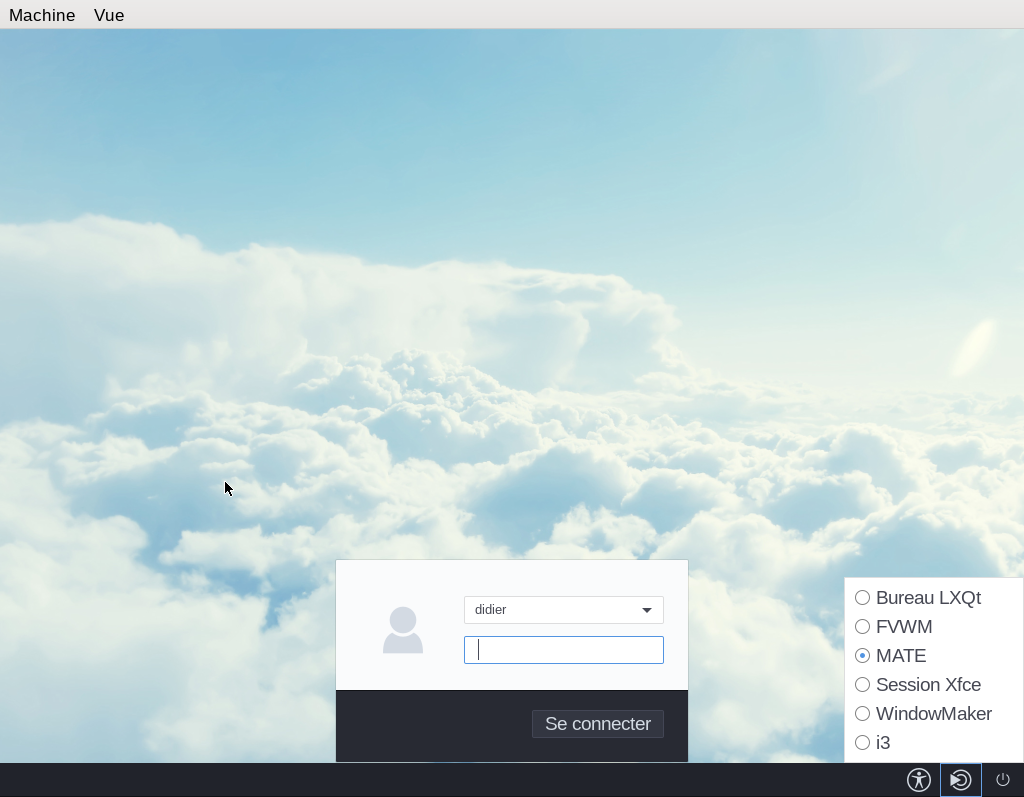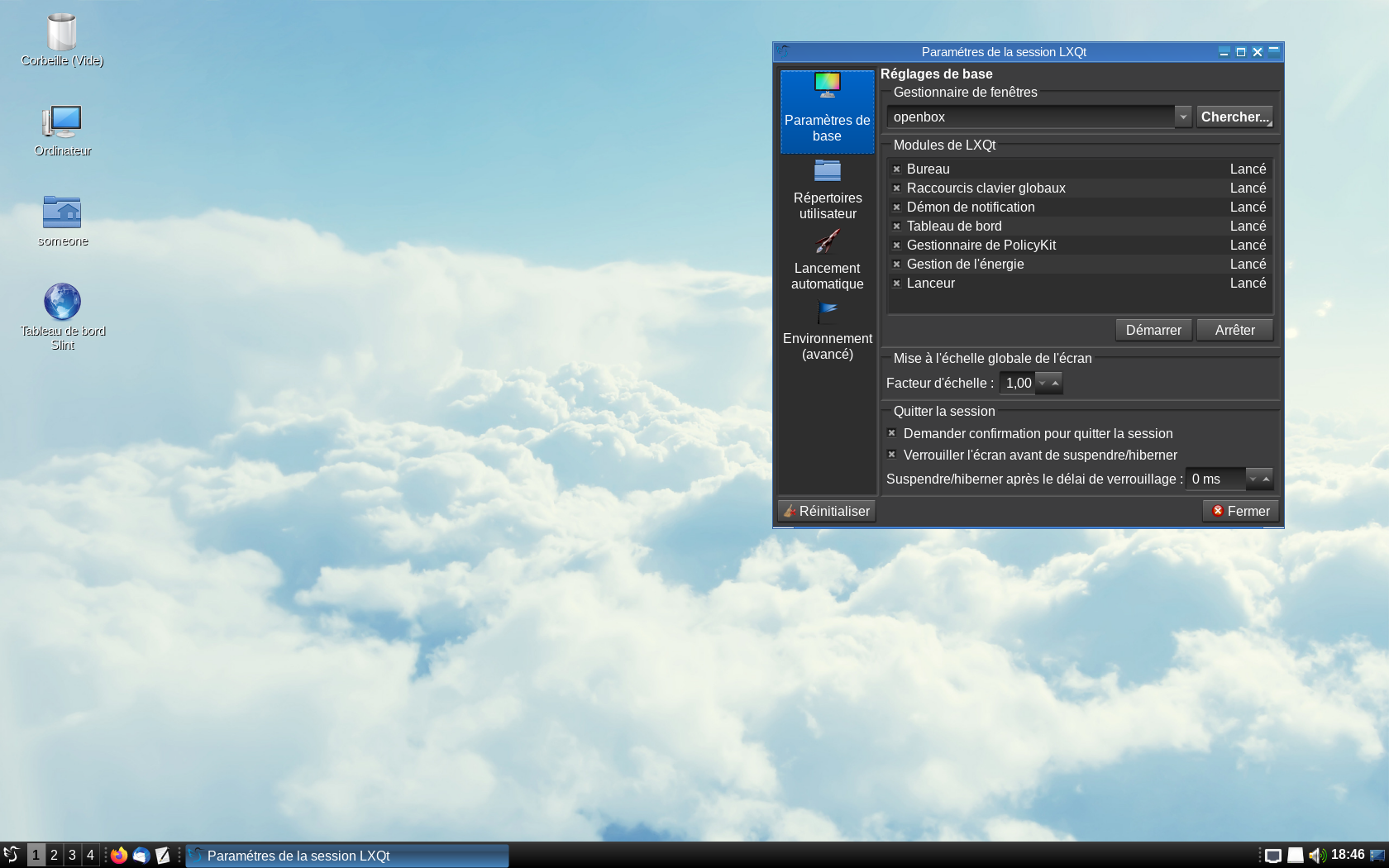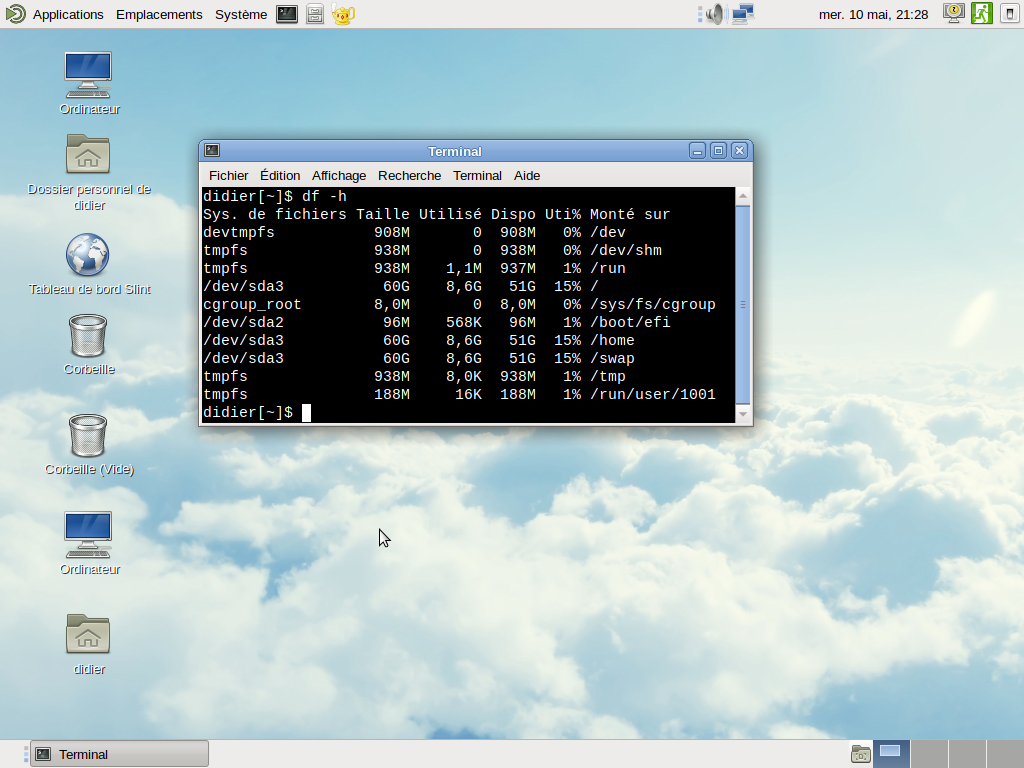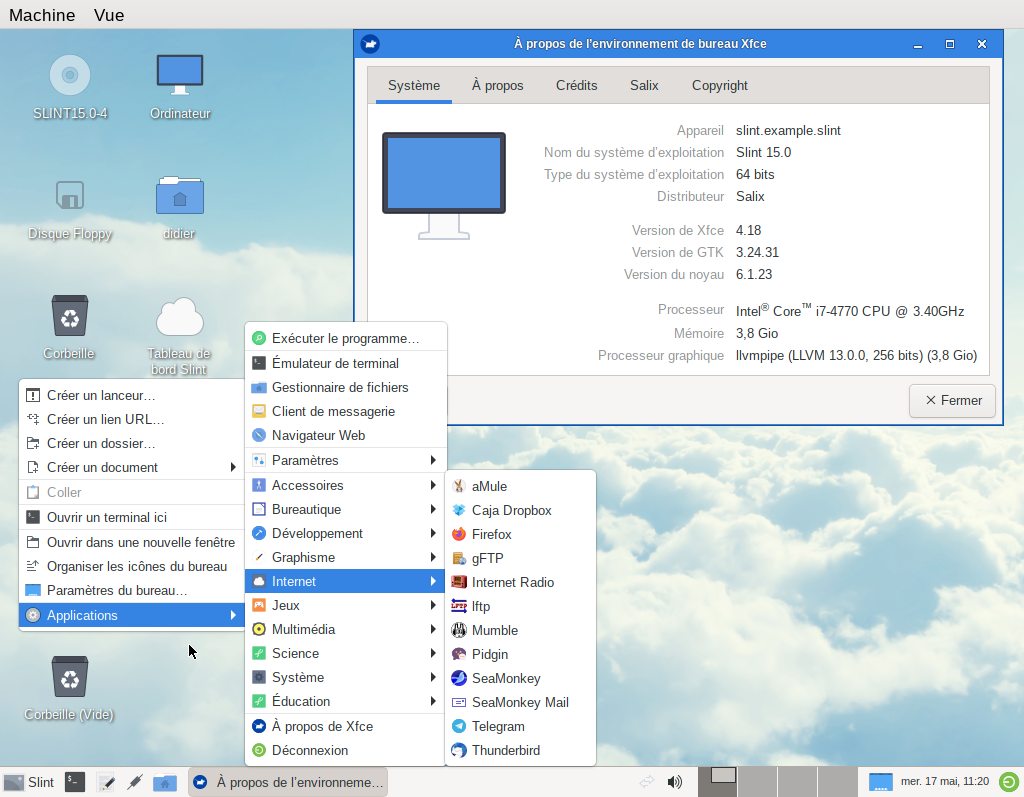1. Novità
1.1. 20 June 2024: Updates preparing the release of a new ISO
The batch of updates available today paves the way for a new ISO that will, beyond these updates and a few fixes of the installer, provide only one desktop: MATE.
Other desktops will be available, either provided in other ISOs, or installable as packages sets provided by contributors, at least the XFCE and LXQt desktops.
The current batch of updates provides mainly:
-
New versions of the MATE and LXQt desktops
-
An enhancement of the visual appearance of the MATE desktop, huge thanks to miss Tell for her many hints and suggestions!
-
An upgrade of several a11y applications to their latest stable versions
-
New and upraded packages in the main repository, /testing or /extra.
The changes are detailed in the Changelog
Before listing the major ones, here is how to make existing desktops look as if they had been installed after the upgrade.
If you want to re-configure MATE to get its new appearance for a given user, just type as this user: dconf reset -f /
Be aware that this will override the customization that you’d have previously done at the user level!
If you want to reconfigure LXQt to get its new appearance for a given user, you need to first get out of LXQt. Either type as root login-chooser text then reboot, or log in another desktop like MATE. Then type as regular user:
rm ~/.config/lxqt/*.conf
cp /usr/share/pcmanfm-qt/lxqt/settings.conf ~/.config/lxqt/
Again, be aware that this will override the customization that you’d have previously done at the user level!
1.1.1. The MATE desktop and the graphical login manager
-
The Mate Control Center is customized for Slint.
-
The Mate tweak application is customized for Slint. It includes several layouts of the panels, including Slint-legacy (the previous layout) and Slint (the new one).
-
The Slint layout provides a single panel including a Brisk menu giving a direct access to several utilities. 3 other menus are available: Advanced, Classic (the default for Slint-legacy) and Compact. In the Slint layout pressing alt-f1 now raises the Compact menu with a single column. In the Slint-legacy layout pressing alt-F1 still raises the Classical menu.
-
The Brisk menu includes at the bottom links to the Slint documentation and mate-tweak and a Favorite area, with by default the Caja file manager, the Mate terminal, Firefox, Thuderbird and the Mate Control Center
-
The default window manager for Mate is now Compiz whith an Emerald theme that can be changed using the custom script switch-emerald-theme. But Marco is still available. The change can be made in mate-tweak. In addition to the CCSM (compiz-config-settings-manager), simple-ccsm is provided in /extra.
-
The lightdm-gtk-greeter is replaced by the lightdm-slick-greeter.
The file /usr/share/glib-2.0/schemas/10.slint-appearance.gschema.override gathers customization of the Mate desktop and some other ones at the distribution level.
1.1.2. The LXQt desktop
This desktop is provided running build scripts provided by Frank Honolka aka snuk, and stored in the lxqt sub-directory, thanks Frank!
This includes the desktop itself and associated applications.
As for Mate the default window manager is compiz and the decorator emerald but openbox is also available. The window manager can be changed from the menu or typing lxqt-config-session
1.1.3. Other upgrades and new software provided, sorted by category
-
Acessibility: at-spi2-core, orca, emacspeak, fenrir, liblouis, liblouisutdml and lios are upgraded.
-
Audio/video: vlc, mpv and yt-dlp are upgraded.
-
The semantic application launchers cerebro, synapse and ulauncher are provided in /testing. A short presentation of them can be found for instance in https://www.debugpoint.com/top-ubuntu-launcher-2022/ and https://softwarelibre166246735.wordpress.com/2020/06/18/10-best-application-launchers-for-linux-desktops/. These launchers allow to start applications but also to find files in your system, do calculations or search the web, for instance, often through plugs-ins.
-
Visual appearance: many themes are added or upgraded: Qogir-icon-theme, emerald-themes (the "overglossed" theme of the emerald decorator is associated with the Compiz window manager), kvantum-theme-qogir, breeze-blue-cursor-theme and breeze-icons for LXQt, papirus-icon-theme, yaru-gtk-theme. Newaita-reborn, posy-cursors and Tela-icon-theme are also available in /testing. Conversely, mate-colors-icon-teme, mate-backgrounds and murrine-themes are removed. Several desktop backgrounds or wallpapers are added.
-
System: btrtbk (backup tool for BTRFS subvolumes) and sof-firmware are added, absm (BTRFS snashot manager), amd-microcode, intel-microcode, kernel, kernel-firmware, and qemu (in /extra) are upgraded. The guake drop-down terminal is added
-
Development: vscode (Visual Studio Code) is added in /extra, nano and emacs are upgraded.
-
Office: LibreOffice and associated help files and dictionaries are upgraded, thanks to Eric Hameleers aka alienBOB and libreoffice-sdkdoc is available in /extra. Remind is also updated.
1.1.4. Known issues
-
After upgrade LXQt can have a black background because the previous default wallpaper has been removed. You can choose another one typing
lxqt-config-appearance, that can also be started form the menu or a left click on the desktop. Alternatively, as indicated above type after a text login:cp /usr/share/pcmanfm-qt/lxqt/settings.conf ~/.config/lxqt/. This will display the new default wallpaper. -
In MATE if started in text mode the date can’t be set using the widget in the boottom panel. Use clocksetup or gtkclocksetup instead.
-
If you disable the display of the desktop icons in mate-tweak, a right click on the desktop becomes ineffective.
1.2. 16 maggio 2023: Un nuovo ISO è disponibile (sì, di nuovo!)
Questo nuovo ISO è fornito principalmente per risolvere il bug descritto in BUG-15.0-3.
Altre correzioni e miglioramenti:
-
L’utente che rifiuta il fuso orario proposto (tramite geoIP), può scegliere di selezionarne un altro o di mantenere quello predefinito (UTC), se non ne è stato proposto nessuno.
-
Il caricatore d’avvio EFI grub.x64.efi è installato in /boot/efi/EFI/slint-$SLINTVERSION, correntemente /boot/efi/EFI/slint-15.0, per aiutare a selezionare la voce d’avvio, se sono installate svariate versioni.
In caso di partizionamento manuale:
-
Se la macchina ha avviato l’installatore in modalità Ereditaria, anche GRUB è installato in modalità EFI se una Partizione di Sistema EFI (ESP) è trovata sull’unità della partizione di root.
-
Se la macchina ha avviato l’installatore in modalità EFI, anche GRUB è installato in modalità Ereditaria, a meno che la partizione di root non si trovi su un’unità con una tabella di partizione GUID (GPT), ma senza alcuna partizione d’avvio BIOS.
Dunque, in gran parte dei casi, il sistema installato potrà avviarsi sia in modalità EFI che Ereditaria, nelle modalità di partizionamento automatiche.
1.3. 10 Maggio 2023: Un nuovo ISO di Slint è disponibile
-
Il desktop i3 leggero è aggiunto, insieme all’utilità I38, che lo rende interamente accessibile con un lettore dello schermo, semplicemente eseguendo il comando i38 dopo l’installazione, grazia a Storm Dragon.
-
La repository xfce4.18-15.0 è abilitata di default, consentendo l’installazione di un desktop xfce-4.18 configurato e completo, semplicemente digitando
slapt-get --install-set xfce, grazie a George Vlahavas. -
Nella modalità di partizionamento
manuale, non è più necessario includere una partizione d’Avvio BIOS in una tabella di partizione GUID (GPT), se la macchina è avviata in modalità EFI, né di una partizione di Sistema EFI se la macchina è avviata in modalità Ereditaria. -
In modalità di partizionamento
automatica, non è consentito inserire la cartella /home nella partizione dedicata, soltanto se è in un’altra unità, rispetto a quella che ospita la partizione principale, montata come /. -
L’utente può selezionare una partizione esistente per /home, possibilmente per continuare a utilizzare una esistente.
-
Se /home è in una partizione già formattata (nel caso in cui l’utente desideri continuare a utilizzarne una esistente), l’installatore offrirà di mantenerne i contenuti o di riformattarla, come con qualsiasi altra partizione di Linux, tranne la principale, montata come /.
-
Tutti i desktop principali (MATE, LXQt, Xfce), come lo schermo di saluto lightDM, hanno lo stesso sfondo "nuvole su cielo blu".
-
Sono stati aggiunti, aggiornati o corretti molti pacchetti dall’uscita della ISO precedente, alcuni di quelli aggiunti sono stati inclusi nell’ISO, tra cui: compsize, confuse, fim, gpart, nushell, Qogir-icon-theme, qogir-theme, salix-xfwm4-theme, rust, testdisk; altri sono disponibili nella repository /extra: calibre, emacs-nativecomp, libgccjit, notmuch, soft.
-
Il menu d’avvio del sistema installato include una voce principale per accedere alla configurazione del firmware in modalità EFI.
-
Se GRUP è installato, è ora possibile avviare l’ISO di installazione memorizzata nella partizione di un disco interno: non è necessario scrivere questo ISO su un DVD o una chiavetta USB, in questo caso. Per farlo, modifica il file /etc/grub.d/40_custom, così che contenga:
#!/bin/sh
exec tail -n +3 $0
# Questo file fornisce un metodo facile per aggiungere voci del menu personalizzate. Basta digitare le
# voci del menu che desideri aggiungere dopo questo commento. Fai attenzione a non modificare
# la riga 'exec tail' precedente.
menuentry 'Slint ISO 15.0-3' {
insmod part_gpt
insmod part_msdos
search --no-floppy --fs-uuid --set=root <UUID>
set isofile='slint64-15.0-3.iso'
loopback loop /repo/x86_64/slint-15.0/iso/$isofile
linux (loop)/linux quiet vga=normal load_ramdisk=1 prompt_ramdisk=0 ro printk.time=0
initrd (loop)/initrd
}
Basta sostituire <UUID> con l’UUID della partizione dove è memorizzato l’ISO. Ad esempio, se l’ISO si trova in /dev/sda3, questo comando produrrà questo UUID: lsblk -lno uuid /dev/sda3. Inoltre, sostituisce /repo/x86_64/slint-15.0/iso/ con il percorso al file ISO. Dopodiché, esegui grub-mkconfig o update-grub così che questa voce d’avvio sia inclusa in grub.cfg. L’installatore di dirà che non riesce a trovare l’ISO e come montarla, se si trova in una partizione del disco interna.
1.3.1. Immagini di lightDM e i desktop principali su Slint
lightDM

LXQt

MATE

XFCE (installato su richiesta)
